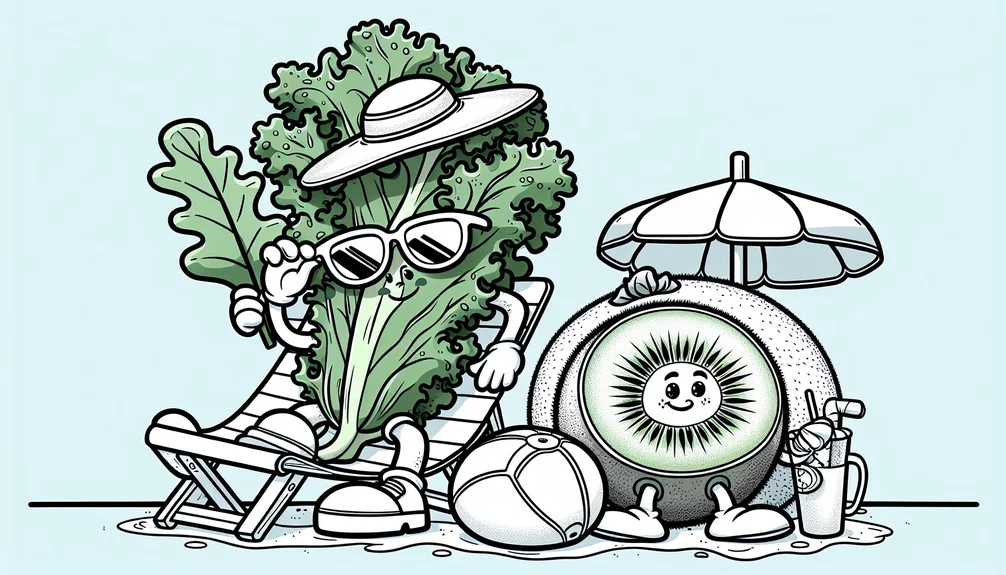20 Vegetables That Start With The Letter K

Today we will be sharing with you some vegetables that start with the letter K. We have quite the list for you!
You will learn about unique vegetables from all around the globe and some fascinating facts about them. So ready to learn something new today, keep on reading.
See also: More Vegetables That Start With
Vegetable Trivia Question
What vegetable was considered a symbol of luxury in ancient Rome? (Answer at the end of the article!).
Vegetables That Start With The Letter K
Kabocha Squash

"Kabocha Squash: A winter's delight that warms you from the inside out."
Kabocha Squash, often hailed as Japanese pumpkin, has a rich history dating back centuries in Japan. Distinctive for its forest green skin and vibrant orange flesh, Kabocha offers a sweet, slightly nutty flavor. Nutritionally, it's a powerhouse, packed with beta-carotene, vitamins A and C, and some iron. Eating Kabocha can boost your immune system, improve eye health, and even help ward off heart disease. While no common allergies are associated with Kabocha Squash, it's a versatile culinary gem in both savory and sweet dishes, from soups and curries to pies.
Kai-lan
Also known as Chinese broccoli, Kai-lan hails from China and shares many similarities with regular broccoli and kale in taste and texture. This leafy green is rich in vitamins A and C, as well as calcium and iron, making it excellent for bone health, improving vision, and enhancing immune function. Kai-lan is a staple in Chinese cuisine, often blanched and served with oyster sauce or stir-fried.
Kailaan
Kailaan is another term for Kai-lan, emphasizing its role in various Asian cuisines with its versatility and health benefits.
Kailan
Kailan, just like Kai-lan and Kailaan, offers the same nutritional profile and is integral to dishes where greens play a central role.
Kale
Considered one of the most nutrient-dense vegetables on the planet, Kale originates from the eastern Mediterranean and Asia Minor. It's brimming with vitamins A, K, C, and minerals like manganese. Kale consumption can enhance your overall health, including supporting heart health, providing bone-building minerals, and packed with antioxidants. Rarely, some individuals might experience bloating due to its high fiber content. Kale shines in the kitchen in salads, smoothies, and chips.
Kamo Kamo
Kamo Kamo, or the Maori squash, is a traditional New Zealand heirloom vegetable, round and often striped, bearing a resemblance to pumpkins and squashes. It's loaded with vitamin A and C, known for bolstering the immune system and skin health. Kamo Kamo is traditionally used in soups and stews but can also be baked or fried.
Kangkong
Kangkong, or water spinach, is popular in Southeast Asian cuisines. It provides significant amounts of vitamins A and C, iron, and antioxidants. Regular consumption can boost eye health and help fight anemia. Allergies are rare but cooking is recommended as it may contain harmful bacteria if consumed raw. It's excellent in stir-fries or as a side dish.
Kelp

Kelp stands out as a unique sea vegetable, famed not only for its origin from the ocean's depths but also for its impressive iodine content, supporting thyroid health. Furthermore, kelp is a source of vitamins A, C, E, and K, along with minerals like magnesium and calcium. Kelp can be incorporated into diets as a supplement or as a salty snack in its dried form.
Kennebec Potato
"The Kennebec Potato: Versatile, hearty and the secret star of your favorite fries."
Originating from the United States, Kennebec potatoes are renowned for their versatility in the kitchen. They provide a good source of vitamin C, potassium, and dietary fiber, aiding in heart health and digestion. These potatoes are allergy-free and are perfect for baking, roasting, and especially frying, making them a popular choice for french fries.
Keriberry
Keriberry, a lesser-known fruit that’s often grouped with vegetables due to its culinary uses, comes from New Zealand. It’s appreciated for its berry-like nutritional benefits, including high levels of antioxidants, vitamin C, and dietary fiber. It’s best used in jams, jellies, and desserts, adding a unique flavor profile.
Kidney Bean
Kidney Beans are not just a staple in chili but also a nutrient-dense legume with origins traced back to Central America and Peru. Rich in proteins, fiber, iron, and antioxidants, they support heart health and stabilize blood sugar levels. Despite their benefits, they should never be consumed raw due to toxic lectins, which cooking can eliminate. Kidney beans are versatile in salads, soups, and, of course, chili.
King Edward Potato
A classic British variety, the King Edward Potato is beloved for its fluffy texture and light, creamy taste. As a good source of vitamin C and dietary fiber, it contributes to immune system health and digestive well-being. They are incredibly versatile in the kitchen, excelling in roasted dishes or mashed potato recipes.
Kinh Gioi
Kinh Gioi, also known as Vietnamese Balm or Lemon Balm, is cherished in Vietnam for its lemony scent and flavor. Offering a wealth of antioxidants and vitamins, it aids in digestion and can relieve stress. No significant allergies are associated with Kinh Gioi. It’s commonly used in salads, teas, and as a garnish in various Vietnamese dishes.
Kohlrabi
Kohlrabi, with its alien-like appearance, actually has roots in Europe. This vegetable offers a great source of vitamin C, fiber, and potassium. Its health benefits include aiding digestion and supporting immune function. Kohlrabi is rarely associated with allergies. Its sweet, nutty flavor makes it versatile in the kitchen, great in salads, soups, or even roasted.
Komatsuna

"Komatsuna: The leafy green that dances between the flavors of mustard and spinach."
Originating from Japan, Komatsuna is rich in calcium, vitamins A and C, and iron. Consuming Komatsuna can strengthen bones, enhance vision, and boost the immune system. This leafy green is a staple in Japanese cuisine, perfect for stir-fries, soups, and salads.
Kombu
Kombu, a type of kelp found in the seas of Japan and Korea, is packed with iodine, aiding in thyroid function, and is a good source of dietary fiber. It’s often used in making dashi (a Japanese soup stock), adding a umami flavor to dishes.
Konjac
Konjac, known for its use in shirataki noodles, is a root vegetable from Asia. It's celebrated for its glucomannan content, a fiber that can aid in weight loss, cholesterol management, and improving gut health. While generally safe, konjac can pose a choking risk if not prepared correctly. Its main culinary use is in noodles and vegan seafood substitutes.
Kovakkai
Kovakkai, or Ivy Gourd, is a small, crunchy vegetable popular in Indian and Southeast Asian cuisines. High in beta-carotene and vitamins, it supports good vision and immune health. Kovakkai is typically used in stir-fries, curries, and pickles.
Kudzu
Kudzu, often known more for its invasive nature, is also a source of various nutrients, including vitamins A and C and calcium. In Asia, its roots are utilized in cooking and traditional medicine to treat ailments like heart disease and diabetes.
Kuka
Kuka, or Baobab leaves, are a staple in African cuisine, known for their high vitamin and mineral content. They can help in boosting immunity, digestion, and are often used in soups and stews.
Kurrat
Kurrat, or Egyptian leek, shares similar nutritional benefits to its close relative, the leek. Rich in vitamins A, C, and K, it can support eye health, immune function, and bone health. Kurrat is primarily utilized in Middle Eastern cuisines, adding a gentle, sweet onion flavor to dishes.
Vegetable Trivia Answer
The vegetable considered a symbol of luxury in ancient Rome was the Asparagus.
Final Thoughts on Vegetables That Start With The Letter K
We hope that you have learned some intriguing facts about the wide world of vegetables beginning with K. From the hearty, versatile potato varieties to the less common but equally fascinating kudzu and kurrat, each vegetable brings its own unique set of flavors, textures, and health benefits to the table.
Exploring these vegetables offers a fantastic opportunity to diversify your diet and perhaps discover a new favorite ingredient. Whether it's boosting your immune system with kale, improving thyroid function with kelp, or experimenting with kovakkai in your next stir-fry, there's no end to how these K-vegetables can enhance your meals and your health.

Related Posts